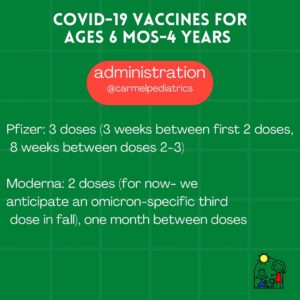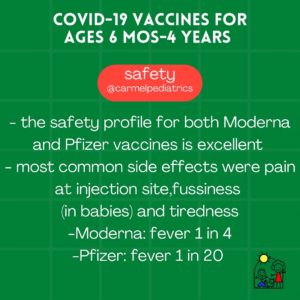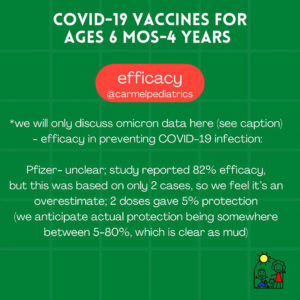COVID Vaccine: 6 Months to 4 Years
COVID Vaccine: 6 Months to 4 Years
By: Danielle N. Wiese, MD, FAAP
We’ve finished digging through allll the data for the Pfizer and Moderna COVID vaccines for ages 6 months to 4 years. If you want the simple breakdown, just read the first slide. If you want the nuances, keep reading and swiping. We want to be as transparent as possible about what people should and shouldn’t expect from these vaccines. First of all, the vaccines are safe. As seen in the older children, it was easier to prevent children from testing positive for delta than it was for omicron. Pfizer efficacy data for virus prevention is complicated because much of their data was based on Delta variant. We have excluded this data because we feel it’s currently irrelevant. The more important endpoint is prevention of serious disease and hospitalization. Both vaccines produced antibody levels similar to vaccinated 5-11 yr olds…therefore we assume that they will invoke similar protection against severe disease and hospitalization (about 70% reduction).
Team Pfizer or Team Moderna? Moderna shows more clear statistics on prevention of contracting COVID-19 (30-40% efficacy) which may increase once they develop their third omicron-specific dose. Pfizer has a slightly lower side-effect profile. We expect both to prevent severe disease and hospitalization.
**We plan to announce clinics in early July. Please follow our socials (FB: CarmelPediatricsLLC and IG: CarmelPediatrics) for more information. All scheduling will occur online. We will email out the link to schedule once we go live. Please refrain from calling our office to schedule appointments, as we want to keep our phone lines clear for medical questions.
The COVID-19 vaccine is here, but my child is afraid of needles! What do I do?
The COVID-19 vaccine is here, but my child is afraid of needles! What do I do?
Written by: Hillary Blake, PsyD HSPP, Child and Adolescent Psychologist
November 9, 2021
Children (and adults) often don’t like getting poked with a needle because it hurts. This leads many children to become afraid of needles. Luckily, there are several techniques that can be utilized to reduce your child’s anxiety, reduce pain, and make your vaccine appointment successful.
- Preparing Your Child for the Appointment:
- Children should never be surprised by a vaccine. Parents should tell their child 1-2 days before the appointment that they will be getting a vaccine. If you have a highly anxious child, it may be best to wait until the day of the appointment. Parents shouldn’t tell a child too soon in advance otherwise, he/she will be worrying about it all week. Surprising the child with a vaccine leads to distrust of medical professionals and parents.
- Be honest that the vaccine will hurt a little bit (describe it as being like a pinch); do not tell the child that it won’t hurt.
- Have an open conversation with your child regarding fears and understanding of the procedure. If parents are aware of the child’s anxiety it is easier to address the child’s concerns.
- Let your child know the benefits of the vaccine in a developmentally appropriate manner. Try to make the vaccine sound exciting! For example, for a five-year-old explain that the vaccine will give them superpowers to fight off COVID-19 and keep the child healthy.
- Teach the child diaphragmatic breathing to help with anxiety during the appointment. Children should practice this skill prior to the appointment (ideally a week before) when the child is calm, as this skill is harder to execute when a child is anxious. Here is a video on diaphragmatic breathing: https://www.choc.org/video/diaphragmatic-breathing/
- Strategies for the Appointment:
- If your child tells you that he/she is feeling scared about being poked, validate his/her feelings, remind the child of his/her pain coping skills to reduce pain, and direct the child to use diaphragmatic breathing. “I know needles are scary because they can be painful. Remember, we have techniques to decrease the pain today. Do you want to use your diaphragmatic breathing with me?”
- Carmel Pediatric nurses do an excellent job of telling your child what they are going to do before they touch a child (e.g., “I’m going to clean your arm”). If you get a vaccine at another site, request that the nurse tell your child what he/she is going to do before touching the child.
- Be near your child to offer physical support. Younger children can sit on the parent’s lap, while older children can sit next to the parent.
- Parents can offer a reward for getting the vaccine. It is important that the child is aware of the reward prior to the appointment and the child is told what behavior he/she needs to exhibit to earn the reward. For example, “First you receive the vaccine, then you can have a piece of candy.” The child should be reminded of the reward and the behavioral expectations when he/she arrives at the vaccine site. The child should be given the reward and verbal praise (“You did such a good job using your coping skills and being brave”) immediately after the vaccine is given.
- Pain Coping Skills:
- Distraction should be used immediately upon arriving at the vaccine site as it decreases pain signal in the brain. Parents can talk to their child about his/her favorite topic, play music/sing songs, or play games (e.g., “I spy”) during the appointment.
- Parents can rub the child’s arm above the injection site to decrease pain signals to the brain.
- Upon entering the exam room, parents should have the child immediately start using diaphragmatic breathing.
4-H in Indiana
4-H in Indiana
By: Carolyn O. Robinson, MD, FAAP
I grew up in a small Indiana community where a popular summer activity was participating in the local 4-H clubs.
A few weeks ago, I had the opportunity to see 4-H’ers in action again when I took my elderly father to the Hendricks County Fair. I wanted to watch a patient show her sheep, and my father wanted to eat a pork burger. We enjoyed both activities and wandered throughout the fairgrounds, seeing the projects 4-H members had worked hard to display.
Are many of you familiar with 4-H? Most county fairs have already happened for this summer, but the state fair is an opportunity to visit the 4-H building and see examples of projects that are on display. Project options are vast, and include animals, but many others for those who don’t have animals. It is a great chance for kids to be creative and try something they might not have done before, as well as a time to gain knowledge in other areas of interest.
There is an annual 4-H overnight camp as well as leadership opportunities for teens, project workshops, and club meetings. Here are some photos of things I learned while I was at the county fair.
4-H sign-up runs from October 1, 2021 through January 15, 2022. For more information, please go to the Purdue Extension Website by clicking here.
We Are INDEPENDENT. What Does That Mean?
We are INDEPENDENT. What does that mean?
By: Nicholas J. Hannah, MSM, Director of Operations

In our eyes, there’s a sizable difference between corporate healthcare and an independent practice. At Carmel Pediatrics, we are smaller. You are going to recognize faces, names, and voices. Our billing department is in house, so if you have questions, we can answer those when you are in the office. Everything we do is catered to you.
We are always looking for ways to streamline our processes, to make it easier to serve you. In corporate life, steps to complete a simple task can be challenging. We want things to simple and straightforward. One of the cool things that we implemented a couple years ago is the ability to text our office directly. These are the types of features that we are always looking to implement that sets us apart from corporate healthcare.
My mission, as the Director of Operations, is to be accessible to all of our amazing patients. If there is anything you ever need, please do not hesitate to reach out to me. The only caveat is that I cannot answer medical questions, so you will still need to call our office to speak with a nurse. You can reach me at 317-582-7875 (my direct line) or by email nick@carmelpediatrics.com.
Bottom line: we are here for YOU. We will go to above and beyond to ensure your children are happy and healthy.
VACCINE BLOG SERIES: Measles
Let’s Learn More About Measles!
By: Anna G. Gilley, MD, FAAP
We are excited to bring to you our next installment of our Vaccine Blog Series, written by our very own, Dr. Anna Gilley.
Measles is one of the most contagious viruses we encounter. It is also a paramyxovirus, and the only natural host is humans. Measles is spread by direct contact and air droplets (i.e., coughing, sneezing, hand shaking, etc.).
Measles is characterized by:
- Fever
- Cough
- Coryza (runny nose)
- Conjunctivitis (pink eye)
- Koplik spots (tiny white dots inside the mouth)
- Red, blotchy rash that begins on the face and spreads to the rest of the body
Measles can have serious complications. Children younger than five (5) years of age and older than 20 years are at higher risk. Pregnant women and patients with a compromised immune system, patients with leukemia and HIV, are also at higher risk.
Complications of measles are:
- Ear infections
- Pneumonia
- Encephalitis (swelling of the brain)
- Hospitalizations (1 out of every 5 patients)
- Death due to respiratory or neurologic complications (1-3 out of every 1,000 children)
- Subacute sclerosing panencephalitis (SSPE) is a rare, but deadly complication that occurs 7 to 10 years after a measles infection
- Pregnant women are high risk of delivering prematurely
Prior to the measles vaccine, 3-4 million people had measles, and of those, 400-500 people died, 48,000 were hospitalized, and 1,000 developed encephalitis.
The measles vaccine was licensed in the United States in 1963, and since then has resulted in 99% decrease in reported cases.
The measles vaccine is a live attenuated virus vaccine that is combined with mumps and rubella (MMR) and sometimes varicella (MMRV). It is recommended that all children receive the vaccine at 12-15 months for the first dose and a second dose at 4-6 years of age. One dose of the vaccine is 93% effective, and 97% effective after the second dose.
Measles was considered eliminated in the United States in the year 2000. Measles still occurs in other parts of the world, and due to travelers, there have been outbreaks here in the US. The largest outbreak since 1992 was in 2019 with 1,292 cases. The majority of the cases were in children that were not vaccinated. The best thing we can do to protect our children and loved ones is to vaccinate.
Sources:
AAP RedBook. 31st edition. Pgs: 537-550
https://www.healthychildren.org/English/health-issues/vaccine-preventable-diseases/Pages/Measles.aspx
https://www.cdc.gov/measles/vaccination.html
Heavy Metals and Baby Food
 Heavy Metals and Baby Food
Heavy Metals and Baby Food
By: Danielle N. Wiese, MD, FAAP
What’s up with these reports of heavy metals in baby food? Heavy metals naturally exist in the foods we eat. Toxicity tells us how much of a problem they pose. Toxicity= exposure over time. Variety is the key to avoiding toxicity. Make sure to give your baby a wide variety of fruits, vegetables, and grains and avoid giving too much of any one particular food. Each food has different levels of different metals, so by switching it up we can decrease the risk of toxicity. balance is key. More information is available on healthychildren.org.
The Story of Mumps
The Story of Mumps
In light of this recent pandemic, understanding why we vaccinate has become more and more important. In the next several weeks, I will be talking about each vaccine preventable disease.
The vaccine preventable diseases are:
- Diphtheria
- Haemophilus influenza type b (HIB)
- Hepatitis A
- Hepatitis B
- Human Papillomavirus (HPV)
- Influenza (flu)
- Measles
- Meningococcal infections
- Mumps
- Pertussis (whooping cough)
- Pneumococcal infections
- Polio
- Rotavirus
- Tetanus
- Varicella (chicken pox)
Today, we will start off with Mumps.
Mumps is a viral infection caused by a virus in the paramyxovirus family. Mumps’ only known host is humans. Mumps can be spread by respiratory secretions, coughing, sneezing, talking, and direct contact. It usually presents with fever, muscle pain, headaches, malaise, pain, and swelling of salivary glands. The infection can last 3-7 days. The infected person can spread the virus two days before the swelling begins, to up to five days after the swelling occurs. About ⅓ of infected patients have no symptoms, but can spread the virus.
In most cases, mumps is mild and self resolves, but it can cause serious complications such as:
- Meningitis (swelling of the lining of the brain and spinal cord)
- Encephalitis (swelling of the brain)
- Orchitis (swelling of the testicles)
- Myocarditis (swelling of the heart)
- Oophoritis (swelling of the ovaries)
- Mastitis (swelling of the breast)
- Pancreatitis
- Deafness
Prior to the Mumps vaccine, Mumps was the leading cause of deafness and meningitis.

Since 1967, the incidence of mumps has decreased by 99%. One single dose is approximately 78% effective, and it is 88% effective after the second dose. Some recent outbreaks indicate that immunity can wane over time. High risk individuals in ages 15-24 years old may need a 3rd dose of the MMR vaccine during outbreaks. High vaccination rates and coverage helps to limit the spread of mumps outbreaks.
Sources:
COVID Safety Precautions …Continued

QUESTION: What will my visit look like now that the doctors and nurses at Carmel Pediatrics have received the COVID-19 vaccine?
ANSWER: Exactly the same!
We will continue to have all our COVID-19 policies and procedures in place: from the parking lot check-in, to masks and other protective equipment, to hand washing and cleaning schedules.
We will continue to see sick children in the office with same day visits and other telehealth in limited situations. Our excellent team of registered nurses (RNs) are available daily by phone to answer your questions. Remember, we are here for YOU!
Pandemic Then vs. Today
 Pandemic Then vs. Today
Pandemic Then vs. Today
By: Carolyn O. Robinson, MD, FAAP
Before 2020, most adults had heard the term “pandemic”, but most of us probably never thought we would go through what we have experienced the last year.
In the recent past in the United States, there was the influenza pandemic of 1918, the polio epidemic in 1948-1952, and the HIV/AIDS pandemic from 1981 to present, with smaller outbreaks of smallpox and various influenza subtypes.

People were afraid. The 1952 polio epidemic was the worst in our nation’s history. The public became aware that the only solution would be a vaccine.
At the time, vaccine development was still a relatively newer science. Two vaccines were eventually created; the Salk vaccine, which was an inactivated polio vaccine, and an oral live, attenuated vaccine by Sabin. Parents, desperate to protect their children, lined up at vaccine distribution sites. Mass immunization results in the last cases of paralytic poliomyelitis in the United States in 1979. Sadly, about seven countries worldwide still suffer from cases of polio where vaccines are not readily available.
We now have two COVID-19 vaccines in use in the United States. Both result in significant protection from the coronavirus with close to 95% effectiveness after two injections.

We can be grateful for this new mRNA technology has produced a solution to our situation, but we have much to learn about better preparation and response for our future.
As George Santaxana said, “those who cannot remember the past are condemned to repeat it.”
Carolyn O. Robinson, MD, FAAP
COVID-19 Testing
With recent changes, we have been receiving several phone calls asking about testing for COVID-19. If you or your child is experiencing COVID-like symptoms, here is an option to consider.
The State of Indiana has partnered with an outside company to assist in helping you find a place to be tested for COVID-19. We have included the link below for your convenience. If you are over the age of 18, you will select the state of Indiana in the drop down menu, and then you will fill out forms with your information. They will then contact you to let you know where you can go to be tested.
If you wish to register a minor for testing, you will need to call 888-634-1116.
Click here to register individuals over the age of 18 for testing.
List of Testing Sites in Indiana
Please note this is for actual testing of the virus. This is not for testing of antibodies.
As always, if you have any questions, please do not hesitate to call our office at 317-582-7257 or 317-582-7360.
Copyright © Carmel Pediatrics 2024. All Rights Reserved. Privacy and Security Policy
Indianapolis Internet Marketing by WSI.
















